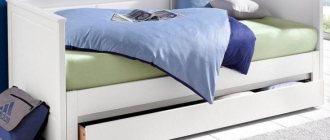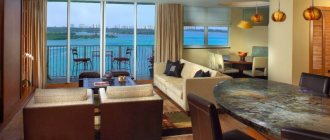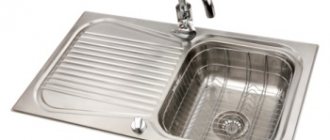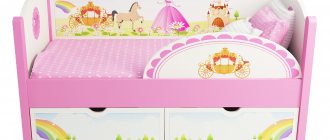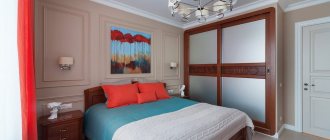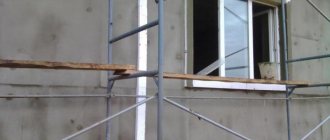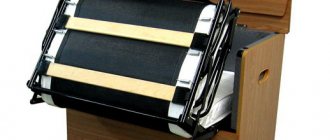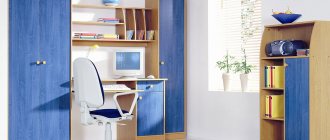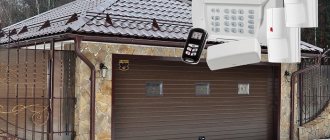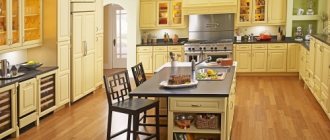An aquarium in the house is a calm and measured world, which even psychologists recommend as a wonderful sedative. Buying a glass cube and fish for it is not difficult; problems arise only in its placement in the apartment. If we are talking about a small aquarium, with a volume of about 20 liters, then it can easily be placed on a regular table or bedside table, only if the surface is leveled. But a household table will not hold an aquarium with a significant volume. That is why such a concept as an aquarium stand appeared, which is a reinforced structure, adjusted in size and color.
Creating a cabinet project
The height, width and depth of a special stand depends on the container that will be installed on it. Experts recommend choosing a height that makes it convenient to watch the fish while sitting in a chair or on the sofa. However, this depends on the wishes of the owners of the house.
When creating a project, you need to take into account the weight of a glass container filled with water and additional aquarium accessories. The tabletop of the cabinet must match the dimensions of the bottom of the aquarium.
It is important to consider that the structure can be used not only as a stand for an aquarium. When planning, you can provide shelves for storing accessories necessary for caring for fish. They may be closed. Open shelves can contain magazines, newspapers, souvenirs, and books.
Correct installation of the aquarium
Finally, you bought the first aquarium in your life and delivered it home. What to do with it next? Is it difficult to install an aquarium? Don't despair, in a couple of minutes you will find out everything. So first:
It must be remembered that when choosing a place for an aquarium, you should take into account some nuances. The aquarium is placed on average at a distance of no less than 1.5 meters from the windows to avoid prolonged exposure to sunlight. Due to constant exposure to direct sunlight, microscopic planktonic algae, which are green in color, multiply in the aquarium, causing the glass to darken. The water “blooms” and the plants in the aquarium become covered with algae threads. It will be very difficult to see fish in such a “swamp”.
The aquarium should be installed with one side facing the window at a right angle. If it is not possible to locate the aquarium in this way, try to limit the exposure of the sun's rays to the aquarium by closing the windows with blinds or blackout curtains.
As a rule, in houses or apartments, the aquarium is placed in the calmest and quietest places, away from heating appliances. It is correct to place the aquarium at eye height of the person looking at it. Here it is worth considering what height will suit you. Perhaps you will watch what is happening in the aquarium, sitting, perhaps standing. When choosing a location for an aquarium, you need to consider the location of electrical outlets.
You also need to know that quite often an aquarium consumes more than a kilowatt of electricity. In this regard, allocate a separate outlet for connecting aquarium equipment.
To install the aquarium, select a place where you can easily approach with a net or bucket, and carry out all the necessary work without difficulty. Otherwise, if you spill water on the floor several times, you may lose interest in the aquarium. You should not place the aquarium in some inconspicuous corner, where, when passing by, you will remember that it is time to clean it.
The aquarium should be easily accessible for work carried out on it, and, most importantly, for observation. There is no need to hide it far. An aquarium is needed for you and your family, friends and loved ones to admire. Now further:
When the location for installing the aquarium has been determined and it is placed on a cabinet or the right stand, and sockets are located nearby, you need to place a sheet of polystyrene under the aquarium, the thickness of which is 10-15 mm. This is necessary to give the aquarium greater stability and even distribution of weight.
Before you start decorating the aquarium, start planting plants, adding fish, attaching equipment, first of all, you should wash the aquarium.
Frameless aquariums are washed with warm water, adding salt or a 5% solution of hydrochloric or acetic acid. Frame aquariums should be rinsed very thoroughly with water at room temperature with the addition of baking soda or laundry soap. If the aquarium you purchased is made using putty, then first remove all excess from the surface of the frame, after which you can wash it. When the aquarium is well washed, you should fill it with water.
After the aquarium has been set up, first of all it is filled with water up to half and only after 24 hours can the water level be increased so that about 5 centimeters remain to its edge. This is necessary to achieve uniform pressure on the walls of the aquarium with water, which will help avoid broken glass. This measure is more necessary for filling large aquariums.
To fill such large containers with water, it is recommended to use a long hose and, using it, pour water into the aquarium directly from the tap. Leave it in this state for about a day. During this period of time you will understand whether it is leaking. After this, all the water from the aquarium must be drained. To do this, you can use a bucket, a long hose or a siphon.
The most interesting and long-awaited moment is the launch of the aquarium. And this moment is not far away. There is no need to rush into purchasing plants and fish. Everything should happen gradually and slowly. Plants must be purchased after consulting with a specialist and finding out which types of plants are right for you. Plants vary in their light-loving qualities, but before purchasing them, look at what kind of lamps you purchased and what power they are.
There are different types of lamps for use in aquariums. All detailed information is posted in the article “Aquarium Lighting”. Take your time when buying fish; you can find out all the information you are interested in by looking at the “Fish Families” menu. In it you can not only read about the types of aquarium fish, but also look at photographs and videos.
The installation of the aquarium has been completed and now we recommend that all beginners familiarize themselves with information about the vital equipment of the aquarium. First of all, it includes all devices for filtering and aerating water in an aquarium. We will talk about this and much more in our next posts.
Selecting the material
The material for the cabinet must be durable and able to withstand the load. In this case, it is necessary to take into account moisture getting on the surface, which can deform it.
To do this, it is better to use waterproof materials : chipboard (chipboard), blockboard or laminated MDF (fine fraction).
Home craftsmen claim that the doors and shelves of a cabinet that is no longer needed can be used as material for an aquarium cabinet.
Dimensions
The size of the cabinet is directly related to the size of the aquarium. The tank is glass, so any distortion or overhang can cause uneven distribution of loads. This situation always ends with the appearance of cracks and destruction of the housing. The main supporting element is the tabletop or upper platform. The successful installation of an aquarium of one size or another depends on its size and shape. It is customary to conventionally distinguish between three types of furniture:
- Small ones. These usually include models that can withstand containers with a capacity of 70–100 liters. The length of the support platform is 0.6–0.7 m with a depth of about 0.3 m.
- Average. On such models you can install an aquarium with a capacity of 120–150 liters. Their length can be 0.7–0.8 m, width - 0.3 m.
- Big ones. These are stands for large tanks with a volume of 200 l to 300 l. The minimum height of the supporting plane should be 1 m. It is important to ensure sufficient strength of such a cabinet, since the load will be very large. Any distortion or sagging can cause destruction of the aquarium with dire consequences.
Popular models of kitchen sink cabinets, their features and sizes
Not only individual cabinets are produced, but also entire sets consisting of 3 tiers:
- lower - supporting structure;
- middle - the tank itself;
- the top - a lid combined with mezzanines.
Usually the capacity of such kits is very large. To ensure reliable support, the design includes additional reinforcing elements and stiffeners. The dimensions of such models are quite large, in length - from 1.5 m, in height - from 1.3 to 2 m. To install a cabinet of this type, you need a large room; it is not advisable to choose such designs in a typical panel apartment.
Small
Average
Big
Three-tier
Decorating and selecting legs for the cabinet
The fittings and decoration of the cabinet depend on the preferences of the household. The craftsman can decorate the stand with carvings or other elements.
The legs or stands for the cabinet can be either metal or wood. In this case, it is necessary to take into account the weight of the structure and the aesthetic nuance.
To assemble the cabinet, you need to have basic tools: a saw, a hacksaw, screws, a drill and drill bits, and emery. The rest is added as needed during the work.
For a cabinet with an aquarium, you need to think through all the elements for installation in detail. Choose the right place in the room, lighting, accessibility to an outlet, take into account the harmony and convenience of its location.
Tips for choosing
The main selection criteria for most users are the size of the aquarium and the cabinet, as well as the combination of its design with the interior of the room. However, this is not enough for the stand to fully function. The following factors must also be taken into account:
- Moisture resistance. The material must be prepared for possible contact with moisture. Insulating coatings are required. During the manufacturing process of the cabinet, a special impregnation must be used.
- Resistance to deformation. The rigidity of surfaces is determined by the thickness of the parts and the properties of the material.
- Strength. The build quality must match the complexity of the task being performed.
- Presence of holes for cords. The wires and tubes necessary to connect the filters and compressor should be placed as secretly as possible. If the design provides special holes or channels for laying wires, the appearance of the kit will be much neater and more attractive.
- Internal organization. Food, spare filters, devices for catching and cleaning the aquarium, care products, and design elements need to be stored somewhere. If there are various compartments inside the cabinet that allow you not to dump all the accessories in one pile, using the product becomes much more convenient.
Review of the main models of shoe cabinets in the hallway, placement options
In addition to these criteria, one should not forget about the size, cost and other features of the cabinet. The optimal option must harmoniously combine the necessary qualities and provide all the requirements and functionality. It is very important that the furniture is safe, especially if children live in the house.
Moisture resistance
Resistance to deformation
Structural strength
Presence of holes for cords
Convenient internal structure

